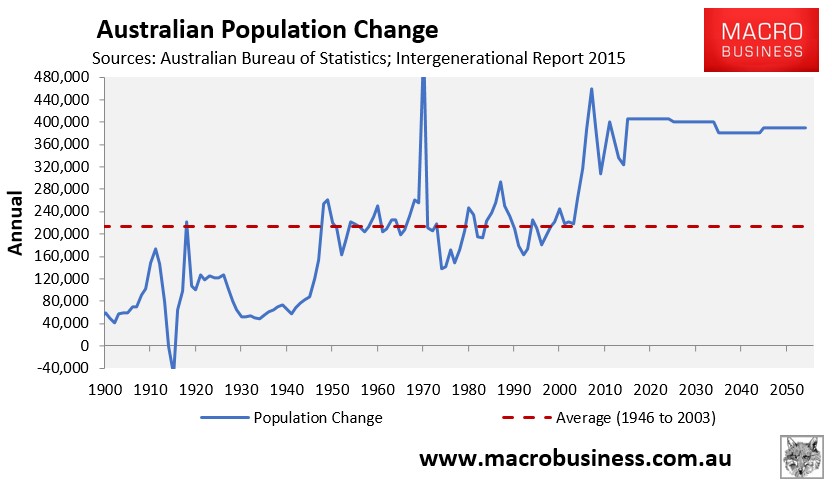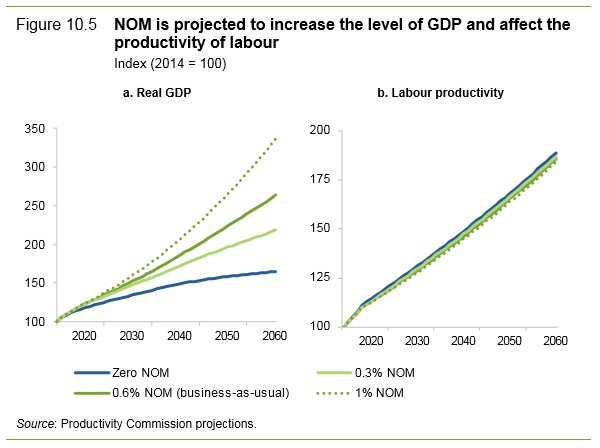Labor senator, Penny Wong, delivered a speech yesterday to the National Press Club entitled Building bridges not walls: the case for an open Australia. As the title suggests, Ms Wong outlined the case for openness towards trade, foreign investment and immigration, most of which I agree with.
The section on immigration, however, is worthy of examination as I believe Ms Wong has made some important omissions that are central to the debate. Below is the extract in question [my emphasis]:
Contemporary Australia’s diversity – which in large part reflects our successful post-War immigration program – is a source of social, cultural and economic strength.
It brings fresh perspectives, fosters creativity and drives innovation – all keys to our future prosperity.
In addition to cultural enrichment, migration also delivers economic benefits.
It boosts demand, and brings in new sources of savings and capital along with new skills, technologies and ideas.
Migrants bring knowledge and contacts in international markets, which strengthen our trade relations and broaden our business horizons.
A more diverse workforce gives Australia a competitive advantage in the global economy.
And, at a time when an ageing population is creating fiscal pressures, immigration can provide a demographic safety valve.
The Productivity Commission has estimated that maintaining migration at our historical rates will increase Australia’s per capita GDP by 7 per cent by 2060 compared to a scenario of zero net migration.
That’s an extra $7,000 for every Australian man, woman and child in current dollars compared to zero net migration – which is the policy of One Nation…
First, by comparing current immigration settings to One Nation’s zero net overseas migration (NOM) approach, Ms Wong has effectively provided a false binary choice. Of course, there is a third option: moderate immigration and much slower population growth.
Between 1946 and 2003, Australia’s population grew by 213,000 per year, which was manageable. However, after John Howard opened the immigration floodgates, Australia’s population growth was ramped-up to an average of 343,000 people between 2004 and 2015. Worse, the Intergenerational Report projects that Australia’s population will grow by an average of 394,000 people per year between 2016 and 2055, representing a further expansion in Australia’s immigration intake and nearly twice the post-war to 2003 level of population growth (see below chart).

Why is such an expanded immigration program more desirable than the one that existed prior to John Howard opening the floodgates?
Second, the so-called $7,000 in ‘benefits’ arising from the Productivity Commission’s (PC) modelling should be taken with a huge pinch of salt. As noted by the PC:
The Commission’s approach to policy development does not aim to increase growth in GDP or GDP per capita per se — it is to maximise the wellbeing of the Australian people. Changes in GDP per capita, while an important contributor to, do not necessarily equate with changes in community wellbeing.
While the modelling suggests that the Australian economy will benefit from migration in terms of higher GDP per person, whether migration delivers an overall benefit to the existing Australian community will also depend on other factors, including the distribution of those economic benefits, and the broader impacts of immigration, notably the associated social and environmental impacts.
New immigrants benefit from an increase in GDP through their own output but only that part of GDP that is transferred to the existing Australian community (Australian citizens and permanent residents) would be directly relevant to its material wellbeing. As the framework for assessing wellbeing centres primarily on the existing Australian community, merely raising GDP per capita does not provide an appropriate metric of successful policy…
The broader impacts from any increase in NOM also need to be taken into account. Increasing numbers of immigrants can adversely affect the quality of Australia’s natural and built environment unless governments take action to mitigate congestion and other pressures. Even with such action, there are additional costs for the community as environmental services have to be replaced with technological solutions…
Moreover, some environmental impacts, such as the recreational value of near empty beaches and the value of biodiversity, are hard to measure, let alone monetise. Yet, such considerations should be part of the broad cost-benefit assessment underpinning decisions on the long-term migrant intake.
Moreover, all of the reported gains to GDP from immigration come from the transitory “demographic dividend” from having a higher proportion of workers in the economy:
Assuming that net overseas migration (NOM) continues at the long-term historical average rate (0.6 per cent of the population), by 2060 Australia’s population is projected to grow to nearly 40 million, with NOM adding some 13 million people to the population.
The continuation of an immigration system oriented towards younger working-age people can boost the proportion of the population in the workforce and, thereby, provide a ‘demographic dividend’ to the Australian economy. However, this demographic dividend comes with a larger population and over time permanent immigrants will themselves age and add to the proportion of the population aged over 65 years.
That’s right, beyond the forecast period (2060), the migrants will age and retire, thus dragging down future growth (other things equal) – classic ponzi demography.
This reported ‘demographic dividend’ also comes at the expense of lower real wages growth and reduced labour force productivity:
Compared to the business-as-usual case, labour productivity is projected to be higher under the hypothetical zero NOM case — by around 2 per cent by 2060 (figure 10.5, panel b). The higher labour productivity is reflected in higher real wage receipts by the workforce in the zero NOM case.
Distributional impacts also matter: there is no point running a high immigration policy if it makes incumbent residents worse-off.
While the PC’s latest modelling does not undertake this analysis, its 2006 modelling did, and found that boosting skilled migration by 50% over the years 2005 to 2025 would actually lower the incomes of incumbent workers, while wealthy capital owners (and the migrants themselves) reap the gains:
The increase in labour supply causes the labour / capita ratio to rise and the terms of trade to fall. This generates a negative deviation in the average real wage. By 2025 the deviation in the real wage is –1.7 per cent…
Broadly, incumbent workers lose from the policy, while incumbent capital owners gain. At a 5 per cent discount rate, the net present value of per capita incumbent wage income losses over the period 2005 – 2025 is $1,775. The net present value of per capita incumbent capital income gains is $1,953 per capita…
Owners of capital in the sectors experiencing the largest output gains will, in general, experience the largest gains in capital income. Also, the distribution of capital income is quite concentrated: the capital owned by the wealthiest 10 per cent of the Australian population represents approximately 45 per cent of all household net wealth…
Having incumbent workers being made worse-off does not sound like an argument for ongoing mass immigration, does it?
The PC’s own report recommends some positive level of NOM – as do I – but this shouldn’t be assumed by Ms Wong that the current high growth settings are optimal:
Overall, the Commission considers that some positive rate of immigration within Australia’s absorptive capacity is likely to deliver net benefits to the Australian community over the long term. However, enhancing community-wide wellbeing is dependent on having an immigration system that attracts young and skilled people, and is responsive to economic, social and environmental conditions.
Finally, as alluded to by the PC above, the economic modelling does not take into account the negative externalities from immigration, including the so-called ‘lived experiences’ of:
- Why you are continually stuck in traffic;
- Why you cannot get a seat on a tram, train or bus;
- Why you or your child cannot afford a home; and
- Why your child’s school and hospitals are overcrowded.
These are all important considerations that have been completely ignored by Ms Wong in her speech. None have anything to do with race – i.e. where the migrants come from – but rather that the overall immigration intake is too high and has overwhelmed the capacity of the economy and infrastructure to absorb them, eroding individuals’ living standards in the process.
MB continues to call for a frank and honest national conversation about population policy, which focuses on raising the living standards of the existing population. Not the current ‘growth is good’ position that blindly assumes that mass immigration is beneficial, and seeks to maintain current high immigration settings and a ‘Big Australia’ in the absence of rigorous evidence nor community consultation and support.


